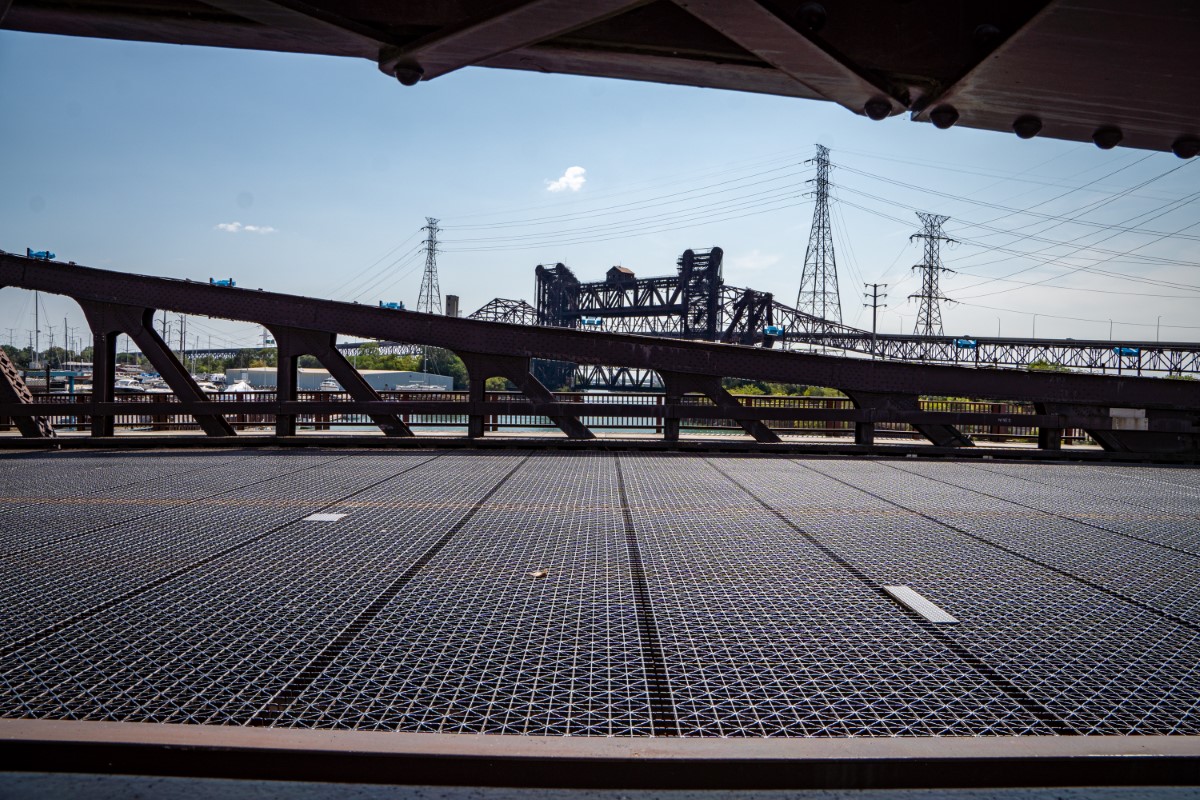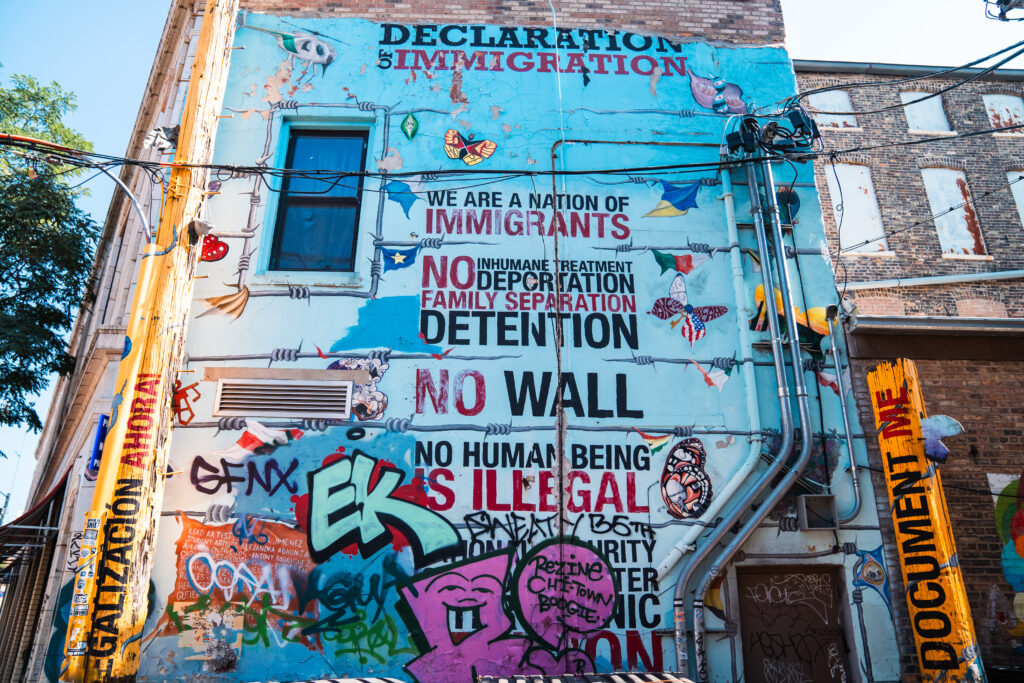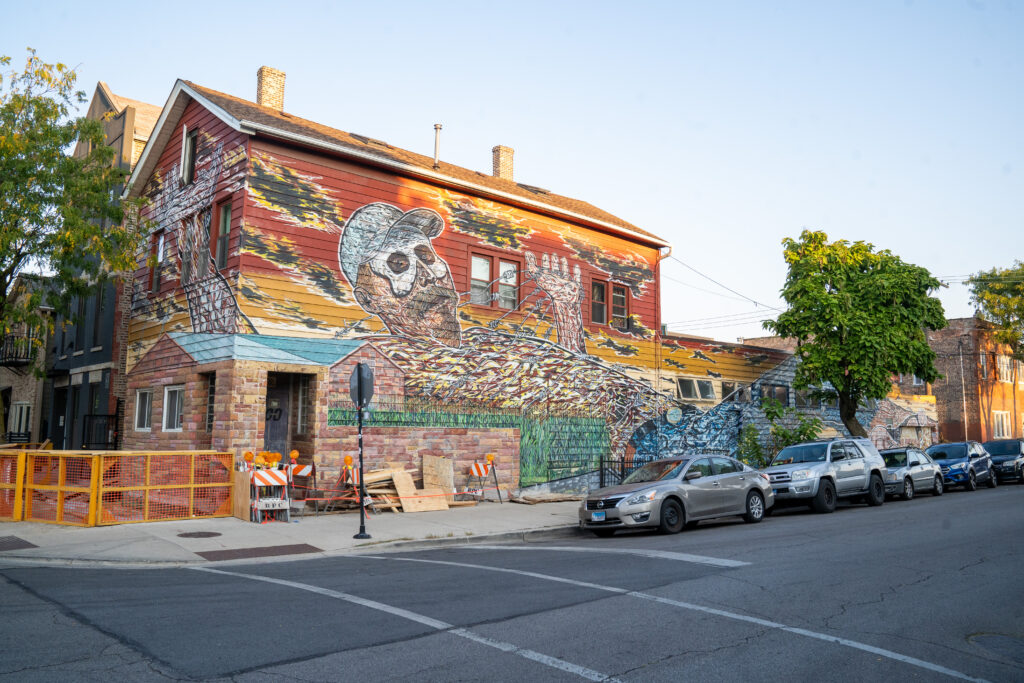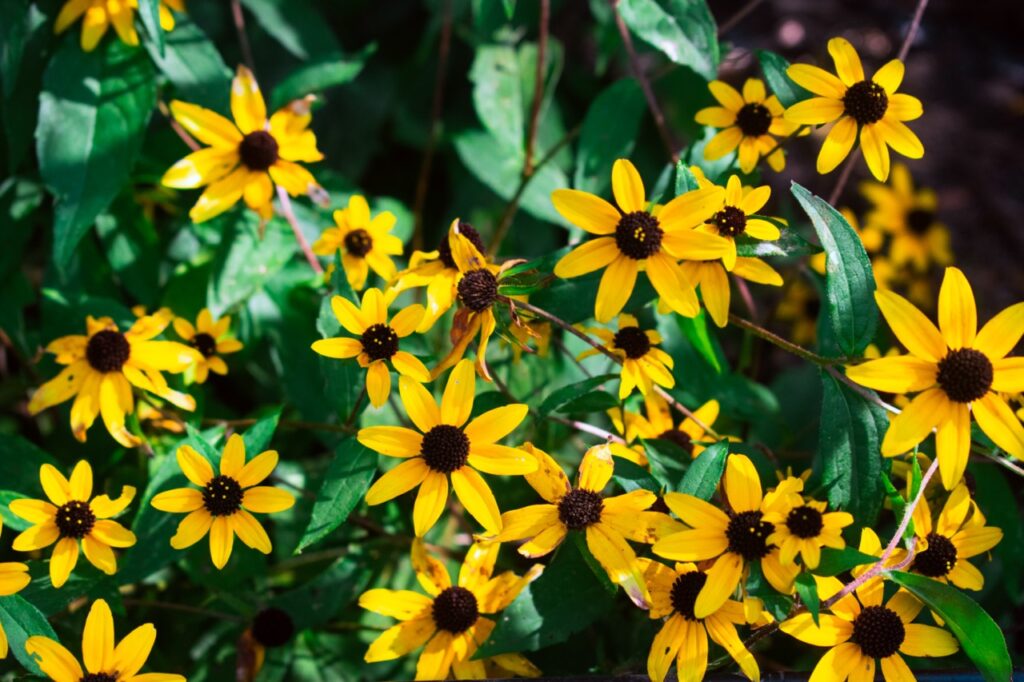While walking, biking, or running in the South Side neighborhoods where I’ve lived, I’ve observed details that remain like vivid mental snapshots.
One of my favorite memories comes from living in the East Side neighborhood on the city’s Southeast Side where massive industrial bridges stand out as the area’s skyscrapers. Their impressive structures and the activity surrounding them continue to inspire me.
These bridges span the Calumet River and various waterways, connecting neighborhoods and industrial areas. In winter, I loved observing them, as the snow, ice, and white morning sky added a dramatic touch. The stark contrast between the structures and the winter landscape creates a unique beauty.
I would meander on foot through the snowy sidewalks past the 95th Street Bridge to get to the bus to the other neighborhood—South Chicago. When this drawbridge went up, I’d have no choice but to wait, as did the cars, sometimes for up to twenty-five minutes to let the freight or oar boats pass. These quiet and still moments of waiting inspired me: the white sky surrounding providing guidance to the chickadees. Making little circles with my shoes, the earth was damp and the ice covered the ground.
A couple of men sometimes sat nearby in this mysterious waterway system moving things from place to place. The sulfur piles, the barges—all have a role to play. And the piles of road salt that sit on the river banks stood like the pyramids of Al Giza Desert.
I later found out that the freight carried in these barges is loaded in Wheelersburg, Ohio, approximately eighty miles south of Columbus along the Ohio River. Then around the bend at Cairo, they are headed up the Mississippi River. The oil from these barges is destined for refineries in Gary and East Chicago, and the iron is transformed into car parts. These parts are then shipped to the local Ford Plant and other factories.
My best friend from high school was scared of crossing this bridge. She was five and one night after she and her family were coming back from a barbecue at Calumet Park, she told me her dad grabbed her from the ankles, flipped her upside down and simulated throwing her in the river beneath the bridge. When she told me this, Alyssa and I were walking back home late one evening and the river and sky were pitch dark with the Skyway twinkling in the distance. We crossed the bridge holding each other’s arms. She scrunched her eyes the whole way—is it over yet?
During my time living in the area, I worked in several shops during high school and college but one of my favorites was a local bakery that filled Commercial Avenue with the delightful aroma of pan dulce each morning. Each week, I’d also get a free bag of pan dulce to take home.
Nearby, there was a mural on the side of a Family Dollar depicting César Chávez, a powerful symbol of the ongoing struggle for workers’ rights and equality. This mural served as a reminder of the importance of advocacy and community during a time when it seemed like everyone was leaving the neighborhood.
One of his most famous quotes was painted on the wall: “We cannot seek achievement for ourselves and forget about progress and prosperity for our community.” As a teenager, I struggled to understand why anyone would choose to stay in a place that seemed to lack opportunity and was marked by disinvestment, heavy manufacturing, broken glass bottles on the ground and boarded-up homes. Yet, years later, as a reporter, I find myself returning to this neighborhood, inspired by the people, the places and especially—the bridges.
Many residents still hold onto their connection to the area, embodying the spirit of Chávez’s quote. It resonates particularly with the work being done by the Centro de Trabajadores Unidos (United Workers’ Center), a grassroots organization established in 2008 which began advocating for immigrant workers who were facing unpaid wages at nearby factories. Now, Centro provides vital support to immigrant families through citizenship workshops, leadership training, and education on workers’ rights. Initially housed in the basement of Our Lady of Guadalupe Church in South Chicago, the center has since relocated to the East Side and, in 2023, opened a dedicated immigrant welcoming center. This evolution reflects not only the community’s enduring spirit but also a commitment to fostering progress and prosperity for all its residents, embodying the essence of Chávez’s message.
Founder and executive director Ana Guajardo, who also grew up in the area, envisions transitioning the center into a self-sustaining social enterprise, reducing reliance on grants and empowering community members with business skills, ultimately allowing the organization to operate independently and effectively serve the community.
Groups like Bridges // Puentes, Alliance of the Southeast, and the movement to Stop General Iron have emerged in recent years to promote awareness of environmental justice and community development. Through events, campaigns, and mutual aid efforts, they engage the community and advocate for sustainable practices, striving to create a healthier and more equitable environment for residents.
Pilsen also holds some of my most cherished memories. It was the first place where I truly had “a room of my own,” becoming the first woman in my family to live independently—a big deal if you come from a Mexican immigrant family.
For my family, who by then had moved to Northwest Indiana, Pilsen was “far.” Although it’s only about a twenty-five minute drive, I can see why they would think it’s “far.” The far Southeast Side has alway been disconnected from everything else. The industrial area is cut off, and a lack of public transportation and easy access to other neighborhoods makes owning a car a necessity for families.
A few years later, what captivated me about Pilsen was the neighborhood’s vibrant energy and the immediate sense of life and pride I felt upon arrival. In no other part of Chicago had I experienced such a strong connection to my heritage. The art throughout Pilsen stirred deep feelings of cultural pride. I was a recent college graduate seeking writing motivation and the murals and community spirit sparked new creativity, reminding me of the importance of identity and expression. Pilsen offered a perfect backdrop for my artistic journey.
But the neighborhood continues with its set of problems including rising gentrification which has raised concerns among long-time residents and community advocates. As new developments and higher-end businesses emerge, rising property values and rents are displacing many families who have lived in the neighborhood for generations. The influx of wealthier newcomers continues to threaten the cultural identity that has long defined Pilsen.
McKinley park on Chicago’s Southwest side is my current home. I fell in love with the park—it is the number one reason I’m here. I also like the grand trees and my neighbors. Living in various neighborhoods across the South Side, I longed for community. The easy access to public transportation, schools and a library at a walking distance, supermarket and being surrounded by other neighborhoods like Chinatown, Pilsen and being a ten-minute train ride from downtown were a score for me.
But the neighborhood has faced significant challenges since the construction of MAT Asphalt in 2018, located just across from the park and in close proximity to homes and schools. The plant’s establishment quickly ignited protests among residents who were concerned about the environmental impacts, including potential air pollution and health risks. The plant’s effects on the community go beyond immediate health concerns, as its presence symbolizes a broader debate over the role of industrial development in residential neighborhoods, particularly in historically underserved areas on the South Side.
While the struggle against MAT Asphalt has been difficult, it has brought the community together in powerful ways. Neighbors, united in their efforts to protect their homes and environment, have found strength in solidarity. Organizations like Neighbors for Environmental Justice have been at the forefront of demanding stricter regulations, greater oversight, and, ultimately, the closure of the plant. Through these shared efforts, I’ve gained new friendships, a stronger sense of community, and a deeper sense of belonging.
These “bests” you’ll read about are just a few of my favorites, marking the beginning of a journey through these South Side neighborhoods.
Best Mexican Panaderia for a Diverse Crowd: Panaderia Marzeya – South Chicago
Walking into Panaderia Marzeya in South Chicago, customers are greeted by the sweet aroma of freshly baked conchas, bolillos, and other Mexican pastries, each prepared with care and attention to traditional recipes.
Upon entering customers will find rows of glass cases filled with buñuelos, puerquitos, cuernitos, conchas of all colors and other sweet confections.
When I worked there as a teenager, I remember customers sharing how they’d been coming to the bakery for decades and how many of them traveled long distances from different neighborhoods after having moved, taking large orders for their families. Some would say they’d been coming here since they were children and shared stories as I packed their bread in a white paper bag or box.
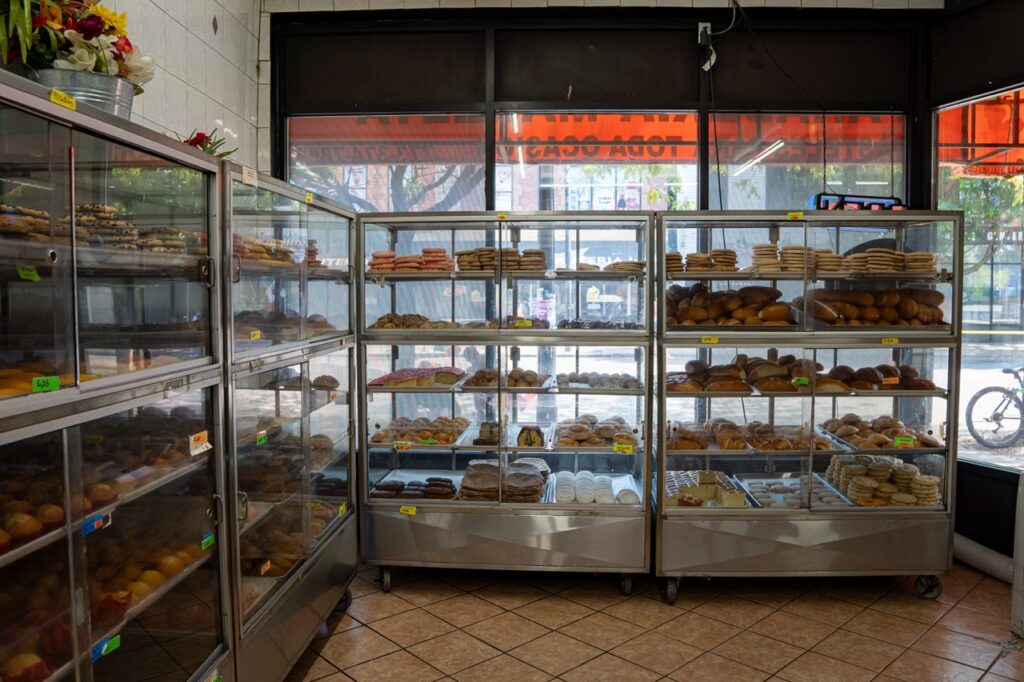
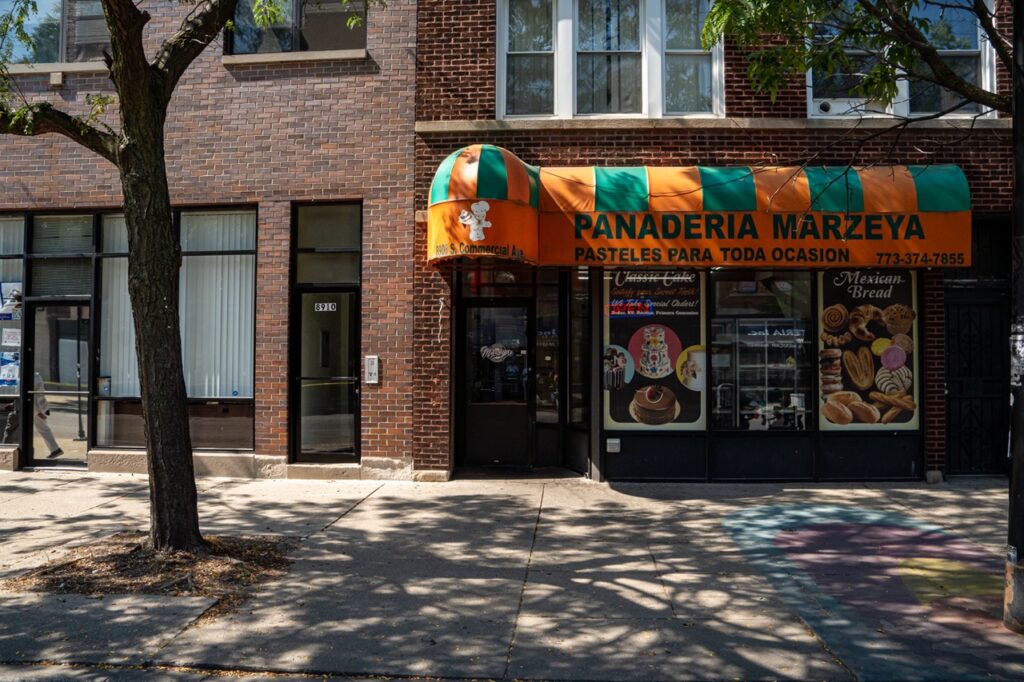
Marzeya’s isn’t just popular among locals or those who grew up with pan dulce at home. It also draws a diverse crowd, including West Africans, who frequent the bakery on Sundays, especially around midday. They come for the toasty French bread and warm croissants. A reviewer, Andrea Sanchez, noted her appreciation for the bakery’s offerings, highlighting its appeal beyond the traditional Mexican community. This cross-cultural connection adds to the bakery’s unique and welcoming atmosphere:
“I spent a lot of time in Mexico as a kid and I crave bread that reminds me of Mexican bakeries. My husband was raised in West Africa and he also craves bread that reminds him of West African bread. Panaderia Marzeya fulfills that craving for both of us.”
During Lent, people also come to find their pan de capirotada—the bread used in capirotada, a traditional Mexican dessert similar to bread pudding. The bread, usually stale, is soaked in a syrup made from piloncillo, cinnamon, and cloves, then layered with ingredients like cheese, nuts, and dried fruits.
But the most sought after item is la Rosca de Reyes. It’s a large ring-shaped bread traditionally made on Three Kings’ Day (January 6th) in Mexico. The candied fruits on top of it symbolize the Wise Men’s crowns. Inside the pastry, small figurines representing baby Jesus are hidden. Those who find a figurine in their slice are expected to host a celebration continuing the holiday festivities.
Some new additions are pan de nata, cupcakes, vanilla and chocolate cakes cut into squares.
New opening hours make it convenient for customers looking for fresh baked goods early in the day. Coffee is also available to go. If you don’t know what to get when you’re there, I recommend croissants or cuernitos.
Panaderia Marzeya, 8908 S Commercial Ave. Monday–Saturday, 4am–8pm; Sundays, 5am–8pm. (773) 374-7855
Best Immigration Narratives Illustrated on Walls: Pilsen Murals – Pilsen
Immigration is a central theme in many of Pilsen’s murals depicting the struggle of crossing borders, family separation, and the fight for dignity and human rights. These murals and so many others unfold vibrantly along the walls of storefronts, narrating stories, honoring lives, and, most importantly, bringing great art within reach of any person with a moment to notice.
Héctor Duarte’s “Gulliver in Wonderland” is a famous mural in Pilsen that symbolizes the immigrant experience, portraying a giant figure trying to break free from barbed wire, which represents both the border and the systemic barriers faced by immigrants.
It’s located on the side of Duarte’s studio at 1900 W. Cullerton Street. The mural, which covers three sides of the building, portrays a Latinx version of Gulliver from Gulliver’s Travels attempting to break free from barbed wire. While the interior of the studio is usually not open to the public, the mural is one of Pilsen’s most popular and can be viewed by all.
The first mural I remember seeing when I moved to the area in 2011 is tucked where the alley begins on 1401 West 18th Street. It’s called the “Declaration of Immigration” created in 2009 at the end of the Great Recession by artist Salvador Jiménez-Flores and youth from the Yollocalli Arts Reach and Radio Arte.
It features powerful imagery, such as barbed wire draped with torn flags from different parts of the world and monarch butterflies, symbolizing migration–carrying empowering messages like “Wake Up” and “Dream Act.” Emblazoned on the wall with large letters are: “No Human is Illegal” and “National Security is Used to Foster Inter-Ethinic Tension.”
This mural is my favorite because it symbolizes the struggles and rights of immigrants from around the globe. And the mural’s location—an alley—adds to its unique character, with tangled power lines, exterior pipes, and an apartment window.
Best Urban Trail to Find Quiet Time: Burnham Greenway in Eggers Woods – Calumet Park
I was going for an early morning run at Calumet Park one day when I discovered the Burnham Greenway. Following other cyclists south, it took me to Eggers Grove and its trails in Wolf Lake. It became my next go-to escape whenever I needed to clear my mind or find some peace.
This trail is around five miles long and typically takes about two and a half hours to complete. It’s ideal for biking, running, and walking, and you’ll likely experience a quiet, peaceful time with few others around. If you’re seeking a laid-back spot to enjoy some solitude while exercising, this is a perfect choice.
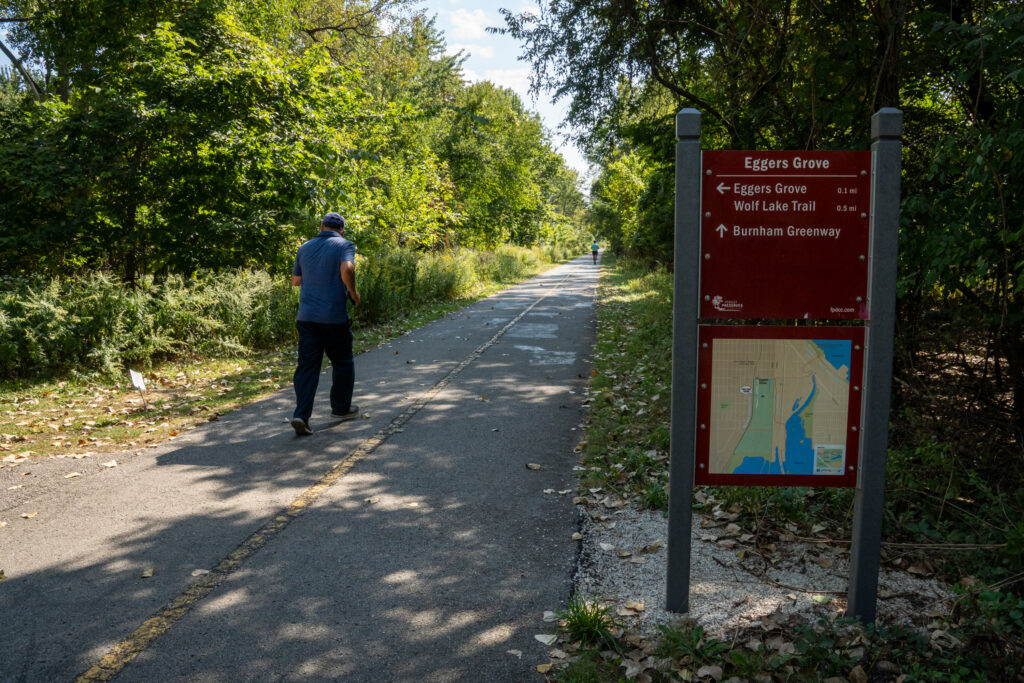

The trail, which is on a former railroad corridor between Chicago and Lansing, connects to Eggers Grove, which is part of Forest Preserves of Cook County and offers a continuous path for biking, walking, and running. The Burnham Greenway stretches north-south, to other green spaces.
In a largely industrial area, Eggers Grove serves as an essential green space. It’s popular for birdwatching, especially due to its proximity to Lake Calumet and its wetlands. The area attracts a variety of bird species, including migratory birds.
Burnham Greenway Trail Access via Eggers Grove, E 112th St & S Ave E.
Best Hidden Nature Gem: McKinley Park Trails
McKinley Park, on Chicago’s Southwest Side, has become one of my favorite places for walking and running. The same is true for residents and surrounding residents from places like Brighton Park and Back of the Yards.
While my daughter enjoys gymnastics, the pool and ice skating, my favorite is the park itself with the lagoon at its center, offering a peaceful escape in the middle of the day, perfect for listening to a podcast, reading a book, or simply taking in the beautiful scenery. Trails meander through the lagoon on the east end of the park in a variety of landscapes, including grassy fields and wooded areas. The park is a haven for birdwatchers, with ducks, geese, and other birds frequently spotted along the paths throughout the year.
This loop, which is about a mile long, offers beautiful views of the water and the surrounding natural environment, an expanse of wildflowers like purple coneflowers and Zizia Aurea. These wildflowers were planted by community stewards during the COVID-19 pandemic for neighbors and visitors to enjoy.
There’s a lot to do for everyone. Its 71.75 acres provide space for outdoor sports, including soccer, baseball, and basketball, as well as indoor activities in its gymnasium and gymnastics center. The park is known for its seasonal offerings, such as ice skating in the winter, arts and crafts activities, an outdoor pool in the summer as well as the summer day camp program—a popular six-week day camp. But as with any Chicago park camp program, spots fill quickly, so it’s good to prepare ahead of time before registering your children. Special events, like Halloween festivities and Movies in the Park, are also offered.
Don’t expect a nightlife or an endless choice of restaurants and bars in McKinley Park. It has more of a close-knit community vibe with the park itself being the heart of the community. Some community spaces to try are Huck Finn’s Restaurant, known for its award-winning donuts; La Placita Supermarket, offering Mexican favorites; and a recently opened coffee shop, Cadinho Bakery & Café that makes Portuguese pastries.
McKinley Park, 2210 W. Pershing Rd. Park open 6am–11pm, fieldhouse open 8am–8pm Monday–Friday, 8am–4pm Saturdays, closed Sundays. (312) 747-6527.

